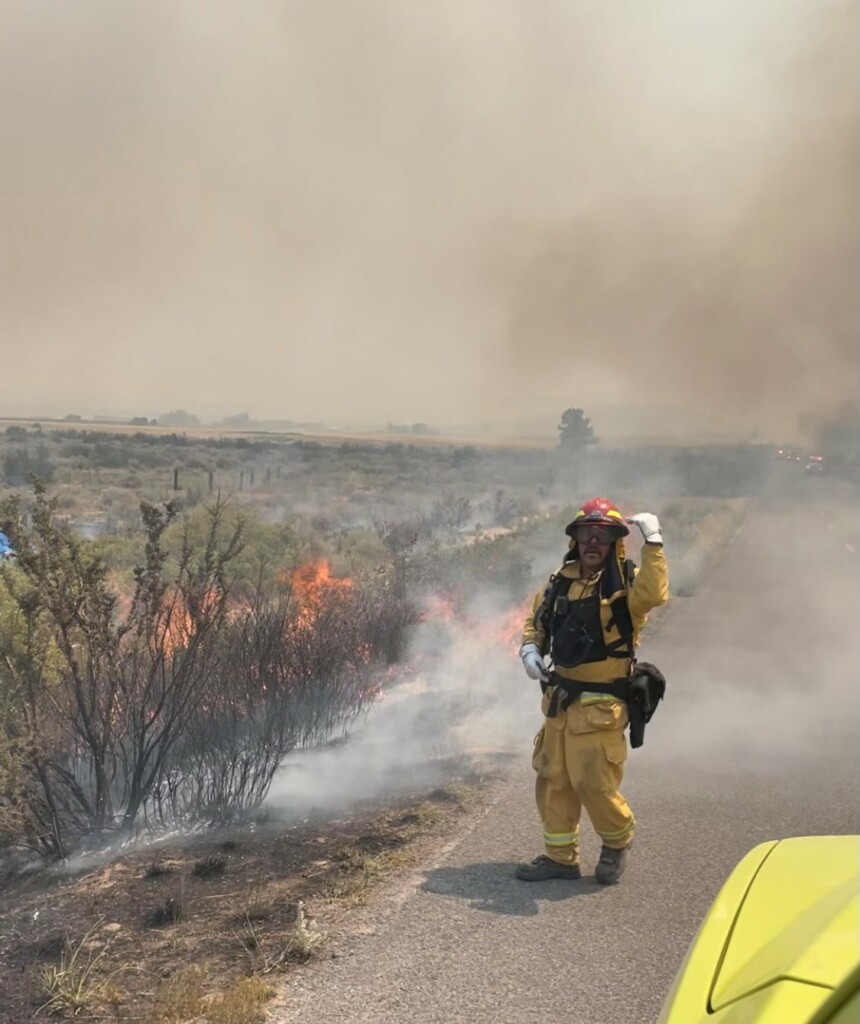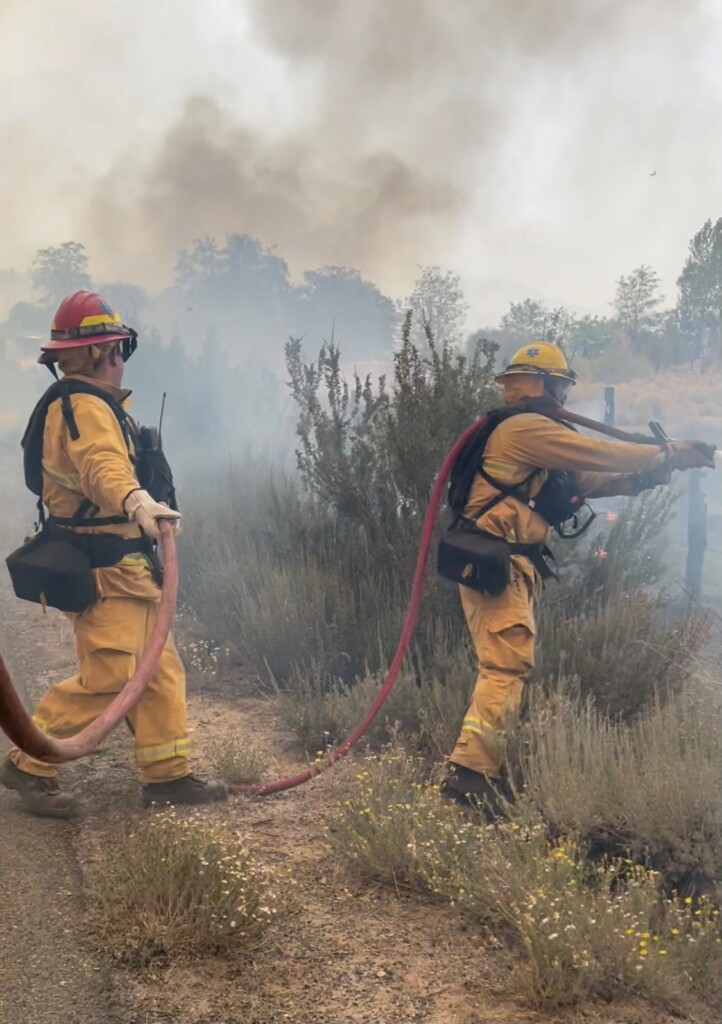Environment: Firefighters deployed to battle Northern California blazes
Severe drought, high temperatures and extremely dry fuels concern local fire departments
![]()

Photo courtesy Gilroy Fire Department
From left to right: fire engineer Stephen Hayes, firefighter Daren Mok, and Capt. Greg Lopez. The three helped fight the Salt Fire in Shasta County.
By Marty Cheek
The ongoing drought and unusually hot temperatures South Valley experienced early this summer may mean this year’s fire season will likely be one for the record books.
Most of the western states including California, Nevada, New Mexico, Oregon, Washington, Idaho and Montana are in either severe or extreme or exceptional drought conditions, according to the U.S. Drought Monitor.
 California’s wildfire season got off to an unusually early start because of the low level of rain and rapidly melting snow in the Sierras during winter and spring. Vegetation is drying out much faster than has been seen in previous years, said Fire Chief Jim Wyatt of the Gilroy Fire Department.
California’s wildfire season got off to an unusually early start because of the low level of rain and rapidly melting snow in the Sierras during winter and spring. Vegetation is drying out much faster than has been seen in previous years, said Fire Chief Jim Wyatt of the Gilroy Fire Department.
Because of the severity of this year’s wildfire season, strike teams have been deployed from cities throughout California to battle the blazes. As of July 23, a total of 5,371 fires in the state this year have been recorded by CalFire, burning 383,279 acres. At least 135 buildings have been destroyed by the wildfires, and at least seven firefighters have been injured.
A crew of three from Gilroy Fire was deployed June 30 as part of a Cal Office of Emergency Services strike team to the 26,000-acre Lava Fire in Siskiyou County. Enroute, a new rapidly growing wildfire erupted at Salt Creek near the town of Lakehead in Shasta County. The team was diverted to this new Salt Fire, which grew to 12,660 acres and was contained July 19.
The Gilroy crew were attached to the various hotshot crews assisting with falling trees and cutting brush in hotspot areas to protect vital roadways and structures. They fought the fire as temperatures exceeded 110 degrees on some days.
 By the eleventh day of their deployment, the Gilroy crew and their Strike Team were redeployed to a fast growing Beckwourth Complex Fire in Plumas County. It has consumed 105,670 acres (the largest in California so far in 2021) since it started by lightning July 3. They saved 11 structures while battling intense winds of 25 to 30 mph with gusts up to 50 mph. The exhausted GFD crew was finally replaced with a fresh crew by July 14.
By the eleventh day of their deployment, the Gilroy crew and their Strike Team were redeployed to a fast growing Beckwourth Complex Fire in Plumas County. It has consumed 105,670 acres (the largest in California so far in 2021) since it started by lightning July 3. They saved 11 structures while battling intense winds of 25 to 30 mph with gusts up to 50 mph. The exhausted GFD crew was finally replaced with a fresh crew by July 14.
Most South Valley residents will recall the wildland fires that burned in the Bay Area last summer. A series of lightning storms hit the Bay Area starting about 4 a.m. Sunday, Aug. 16, 2020, sparked dry grass and brush in dozens of locations. The flames, spread by the force of strong winds, consumed more than 550,000 acres. Smoke hung heavy over much of the Bay Area including the communities of Morgan Hill and Gilroy, forcing people with respiratory problems to stay inside.
This year’s exceedingly dry conditions indicate 2021 presents similar risks of wildfires, Wyatt said. Locally, fire experts are warning of conditions where the natural brush and vegetation such as manzanita — which is known as a “10-hour fuel” — is down into 4 to 6 percent moisture levels. Trees such as pines and oaks are “1,000-hour fuels” and are down to six to eight percent moisture levels.
In comparison, the driest lumber at a hardware store is at 11 percent moisture level, Wyatt said.
“Right in our own backyard, we’ve had some pretty large fires just last year,” he said. “When we start looking at current conditions and the fact that the wildland fire season has started pretty early, we’re seeing conditions related to us by CalFire in early April. They said they were the exact same conditions that we should see in August. That’s how soon we were starting to see some indications that the drought was starting to take its toll on our forests and vegetation.”
 Red Flag Days will be common for the next several months to warn residents to take extra care to prevent wildfires from happening due to human activity. On these days, a red-colored flag will hang under the U.S. flag at local fire stations.
Red Flag Days will be common for the next several months to warn residents to take extra care to prevent wildfires from happening due to human activity. On these days, a red-colored flag will hang under the U.S. flag at local fire stations.
Conditions for Red Flag Day include when the temperature is higher than 75 degrees, winds are 15 miles or more per hour, and humidity lower than 10 to 20 percent.
Driving around Gilroy and the surrounding area, Wyatt has seen a considerable amount of work done by homeowners who have taken out sappy trees such as junipers from near their house and cut back brush and mowed dry grass down to ground level. CalFire recommends keeping at least 100 feet of defensible space around homes in fire-prone areas.
“I feel better that we’re more prepared this year compared with last year. Unfortunately, it took a megafire in our backyard to bring that lesson home. But we’re not out of the woods yet,” Wyatt said. “The fire season has gotten an early start and I don’t see it abating any time soon, not until we have a good rain, possibly as late as January.”
 Climate change conditions and more homes being built in Wildland Urban Interface (WUI) areas have added considerably to the danger to lives and property, he said.
Climate change conditions and more homes being built in Wildland Urban Interface (WUI) areas have added considerably to the danger to lives and property, he said.
“Conditions have gotten much worse as a result of climate change, and it doesn’t help that California is in a severe drought right now,” Wyatt said. “You couple all that together with conditions where the vegetation is drying out sooner and staying dry for long periods of time, the fire season has been extended.”
One of the biggest concerns for local firefighters are illegal fireworks shot off by people in neighborhoods and backyards. Last year’s Holiday Estates Fire in the hills of eastside Morgan Hill was started by illegal fireworks’ burning ash landing on dry grass. Fireworks in 2017 started the 100-acre Ballybunion Fire in westside Gilroy.
“Illegal fireworks are the number one cause of our fires in Gilroy,” Wyatt said. “And I can safely say that’s probably pretty true about fires in other cities. More than once we’ve seen an illegal firework that someone intended not to do anything with other than shoot them off and let them explode, but it fell over and blew into the brush and caused the brush to go on fire.”
